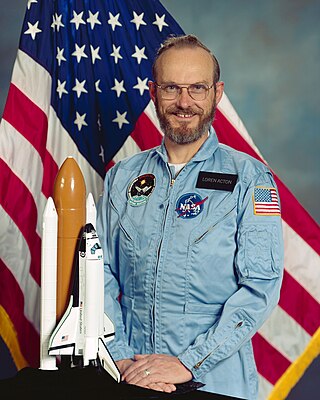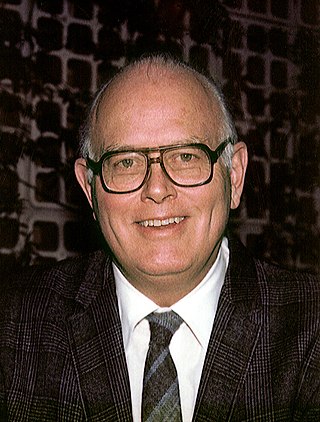Related Research Articles

Loren Wilber Acton is an American physicist who flew on Space Shuttle mission STS-51-F as a Payload Specialist for the Lockheed Palo Alto Research Laboratory. He is also the father of Cheryll Glotfelty, a leading ecocritic.

Masatoshi Koshiba was a Japanese physicist and one of the founders of neutrino astronomy. His work with the neutrino detectors Kamiokande and Super-Kamiokande was instrumental in detecting solar neutrinos, providing experimental evidence for the solar neutrino problem.

The American Astronomical Society is an American society of professional astronomers and other interested individuals, headquartered in Washington, DC. The primary objective of the AAS is to promote the advancement of astronomy and closely related branches of science, while the secondary purpose includes enhancing astronomy education and providing a political voice for its members through lobbying and grassroots activities. Its current mission is to enhance and share humanity's scientific understanding of the universe as a diverse and inclusive astronomical community.

Dame Susan Jocelyn Bell Burnell is an astrophysicist from Northern Ireland who, as a postgraduate student, discovered the first radio pulsars in 1967. The discovery eventually earned the Nobel Prize in Physics in 1974; however, she was not one of the prize's recipients.

Eugene Newman Parker was an American solar and plasma physicist. In the 1950s he proposed the existence of the solar wind and that the magnetic field in the outer Solar System would be in the shape of a Parker spiral, predictions that were later confirmed by spacecraft measurements. In 1987, Parker proposed the existence of nanoflares, a leading candidate to explain the coronal heating problem.

Raymond Davis Jr. was an American chemist and physicist. He is best known as the leader of the Homestake experiment in the 1960s-1980s, which was the first experiment to detect neutrinos emitted from the Sun; for this he shared the 2002 Nobel Prize in Physics.
Jay Myron Pasachoff was an American astronomer. Pasachoff was Field Memorial Professor of Astronomy at Williams College and the author of textbooks and tradebooks in astronomy, physics, mathematics, and other sciences.
Scott Duncan Tremaine is a Canadian-born astrophysicist. He is a fellow of the Royal Society of London, the Royal Society of Canada and the National Academy of Sciences. Tremaine is widely regarded as one of the world's leading astrophysicists for his contributions to the theory of Solar System and galactic dynamics. Tremaine is the namesake of asteroid 3806 Tremaine. He is credited with coining the name "Kuiper belt".
The George Ellery Hale Prize, or Hale Prize, is awarded annually by the Solar Physics Division of the American Astronomical Society for outstanding contributions over an extended period of time to the field of solar astronomy. The prize is named in memory of George Ellery Hale.
The Arctowski Medal is awarded by the U.S. National Academy of Sciences "for studies in solar physics and solar-terrestrial relationships." Named in honor of Henryk Arctowski, it was first awarded in 1969.
Adam Frank is an American physicist, astronomer, and writer. His scientific research has focused on computational astrophysics with an emphasis on star formation and late stages of stellar evolution. His work includes studies of exoplanet atmospheres and astrobiology. The latter include studies of the generic response of planets to the evolution of energy-intensive civilizations (exo-civilizations).
Dibyendu Nandi is an Indian space scientist known for his studies related to Solar Magnetic Cycle, solar dynamic activity and its influence on Space Weather. He is associated with Montana State University, Center for Astrophysics | Harvard & Smithsonian and IISER Kolkata where he carried most of his research work. He is currently the Head of the Center of Excellence in Space Sciences India (www.cessi.in) which was established by the Ministry of Human Resource Development, Government of India at IISER Kolkata. At CESSI, his research on understanding and predicting the varying space environment of Earth has led to the establishment of India's first operational space weather forecasting lab.

Craig Edward DeForest is an American solar physicist and the Chair of the American Astronomical Society's Solar Physics Division. He leads the heliophysics research group at the Boulder, Colorado offices of the Southwest Research Institute and holds an adjunct faculty position at the University of Colorado, Boulder. His wide-ranging contributions to the field of experimental astrophysics of the Sun include: early work on the MSSTA, a sounding rocket that prototyped modern normal-incidence EUV optics such as are used on the Solar Dynamics Observatory; his discovery of sound waves in the solar corona in 1998; standardization of computer vision techniques that are used to measure and track magnetic fields on the solar surface; co-invention with colleague Charles Kankelborg of the fluxon semi-Lagrangian approach to numerical MHD modeling; and pioneering work on quantitative remote sensing of the solar wind via Thomson scattered light.

Takaaki Kajita is a Japanese physicist, known for neutrino experiments at the Kamioka Observatory – Kamiokande and its successor, Super-Kamiokande. In 2015, he was awarded the Nobel Prize in Physics jointly with Canadian physicist Arthur B. McDonald. On 1 October 2020, he became the president of the Science Council of Japan.
Katharine Reeves is an astronomer and solar physicist who works at the Center for Astrophysics | Harvard & Smithsonian (CfA).. She is known for her work on high temperature plasmas in the solar corona, and measurement/analysis techniques to probe the physics of magnetic reconnection and thermal energy transport during solar flares; these are aspects of the coronal heating problem that organizes a large part of the field. She has a strong scientific role in multiple NASA and international space missions to observe the Sun: Hinode ; IRIS ; SDO; Parker Solar Probe; and suborbital sounding rockets including the MaGIXS and Hi-C FLARE high-resolution spectral imaging packages.

The European Solar Physics Division (ESPD) of the European Physical Society (EPS), is an organisation whose purpose is to promote solar physics and represent European scientists interested in the physics of the Sun. The ESPD is known mostly for its organisation of the European Solar Physics Meetings, which bring together European solar physicists and take place every three years.

Lindsay Erin Glesener is a professor in the Institute for Astrophysics at the University of Minnesota. She is a National Science Foundation CAREER Award researcher and lead investigator on the FOXSI Sounding Rocket.

Richard Brandner Dunn was an American solar physicist and astronomer who was a pioneer in solar physics. He is known for his designs of solar telescopes and their instruments, most notably the Richard B. Dunn Solar Telescope. At the time of his death he was astronomer emeritus of the National Solar Observatory.
Nicholeen Viall is an American solar physicist who is the vice-chair of the American Astronomical Society's Solar Physics Division. Viall is known for her work on connecting dynamics of the solar corona to dynamics of the solar wind, based on observed variability of the corona-heliosphere system with both remote-sensing instruments and in-situ probes, and for her work on understanding evolution of the plasma in the inner heliosphere. She is the mission scientist for NASA's PUNCH mission, and a co-investigator on the ISS/CODEX and Parker Solar Probe/WISPR coronal imaging instruments.
References
- ↑ Boswell, Evelyn (17 January 2013). "Canfield wins major solar physics award". Montana State University . MSU News Service. Retrieved 8 February 2015.
- ↑ Johnson, Pamela (30 July 2014). "Solar physicist's Mount Wilson work shines brightly". USC News. Retrieved 8 February 2015.